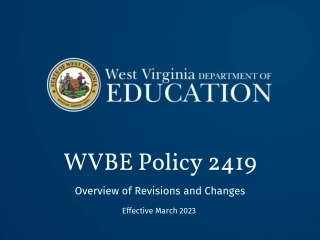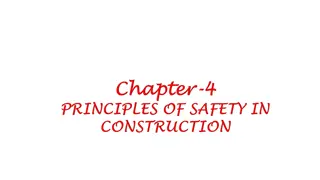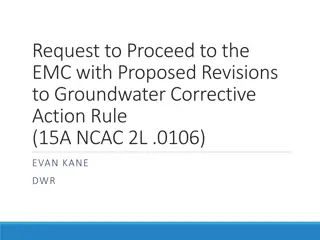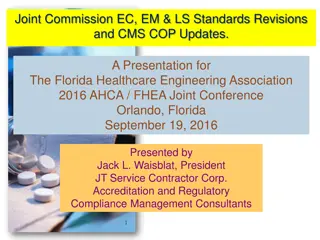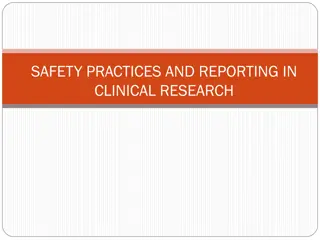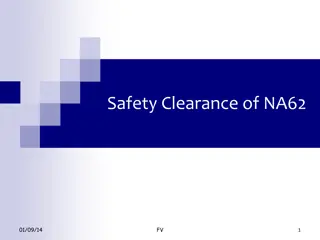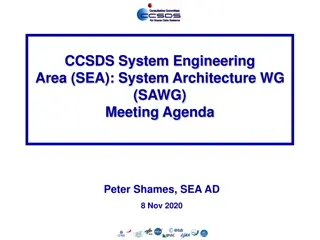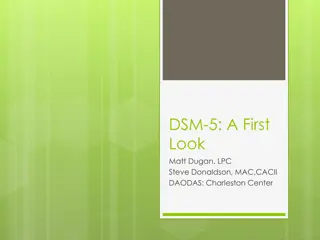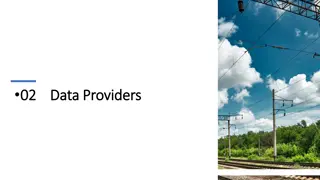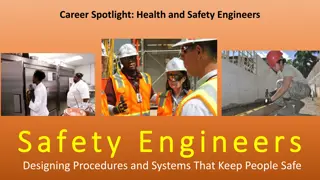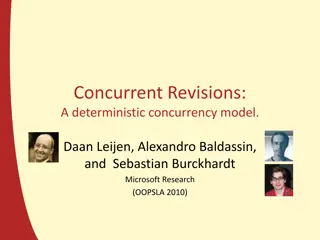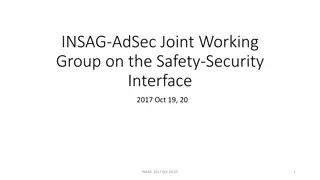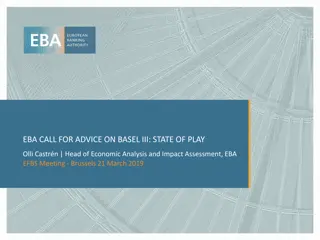Potential Revisions for Process Safety Management
This content highlights potential revisions for Process Safety Management (PSM) focusing on atmospheric storage tanks, oil and gas well operations, chemical reactivity hazards, and more. Recommendations include clarifying language in regulations, removing exemptions, and addressing safety hazards in various sectors to enhance workplace safety.
Download Presentation

Please find below an Image/Link to download the presentation.
The content on the website is provided AS IS for your information and personal use only. It may not be sold, licensed, or shared on other websites without obtaining consent from the author.If you encounter any issues during the download, it is possible that the publisher has removed the file from their server.
You are allowed to download the files provided on this website for personal or commercial use, subject to the condition that they are used lawfully. All files are the property of their respective owners.
The content on the website is provided AS IS for your information and personal use only. It may not be sold, licensed, or shared on other websites without obtaining consent from the author.
E N D
Presentation Transcript
Process Safety Management SBREFA Panel Issues
Potential PSM Revisions Atmospheric Storage Tanks Oil and Gas-Well Drilling, Servicing, and Production Chemical Reactivity Safer Technology and Alternatives Additions to Appendix A Chemicals Dismantling/Disposal of Explosives Define/Updating RAGAGEP
Potential PSM Revisions Mechanical Integrity Employee Participation Emergency Planning Third-party Audits Stop Work Authority Root Cause Analysis Other Management System Components Additional Minor Modifications
Atmospheric Storage Tanks Current: Exemption for [f]lammable liquids stored in atmospheric tanks or transferred which are kept below their normal boiling point without benefit of chilling or refrigeration. 1910.119 (a)(1)(ii)(B) Issue: Exempts processes that are interconnected to storage tanks. Difficult to interpret coverage. Option: Changing the language in 1910.119(a)(1)(ii)(B) to make clear that it applies only to processes in NAICS 4247 Petroleum and Petroleum Products Merchant Wholesalers.
Oil and Gas-Well Drilling, Servicing, and Production Current: Exemption of facilities in Oil and Gas Well Drilling, Servicing from PSM coverage. The PSM standard has not been enforced at Oil and Gas production sites, which is a phase of well operations that deals with bringing well fluids to the surface, separating them, and then storing, gauging and otherwise preparing the product for the pipeline, because of missing economic analysis. Issue: Significant PSM safety hazards in these sectors Option: Remove the exemption for oil and gas well drilling and servicing operations in 1910.119(a)(2)(ii) and specifying that the standard applies to oil and gas well drilling operations, regardless of threshold quantities present. Complete the economic analysis for oil and gas production.
Chemical Reactive Hazards Current: Appendix A chemical list has only limited number of chemicals with reactivity hazards Issue: Chemical reactive hazards have caused significant incidents Option: Adding language to 1901.119(a) extending coverage to processes that mix substances with a listed functional group, if the heat of reaction is above 100 kcal/mol or if the reaction generates a toxic product and the substance is at the threshold quantity. Adopt functional group list from NJ TCPA Guidance.
Safer Technology and Alternatives Current: No requirement of analysis of safer technology and alternatives under PSM Issue: Safer technology and alternatives analysis may identify safer solutions to current risks that currently are being missed Option: Requiring employers to use the hierarchy of controls in considering safer alternatives and technology when identified hazards result in an employer-specified level of risk.
Dismantling/Disposal of Explosives Current: Under OSHA regulation 1910.109(k)(2) and (3), manufacture of explosives is covered under PSM Issue: Dismantling and disposal of explosives can be as dangerous as manufacture Option: Extending PSM Include coverage to the of dismantling and disposal of explosives by including these operations in 1910.109(k)(2) and (3)
Additions to Appendix A Chemicals Current: Appendix A list of covered chemicals Issue: Update list of highly hazardous chemicals Option: Addition of specific chemicals to Appendix A Hydrazine, anhydrous Perchloric Acid, greater than 50% but less than 72% Picric Acid, wet, with not less than 10% water Sodium Hydroxide Toluene Diisocyanate Ammonium Nitrate Butyl Peroxyacetate, Tertiary Butyl Peroxypivalate, Tertiary Chlorodinitrobenzene Diethylaluminum Chloride Diethyl Telluride Dinitrobenzenes Dinitrotoluenes, molten liquid or solid
Update RAGAGEP Current: There is no requirement that employers update RAGAGEP to reflect revisions made since the employer initially adopted it. Issue: RAGAGEP can change over time and firms may not be implementing current best practices Option: Require periodic review of current RAGAGEP and implementation of updates
Mechanical Integrity Current: Mechanical Integrity element, 1910.119(j), applies only to six explicit categories of equipment Issue: Other types of equipment that do not fall in these six categories also have hazards that should can be addressed by the Mechanical Integrity requirements Option: Expand 1910.119(j) to include all equipment deemed critical
Additions to employee participation plan Current: Employee consultation required under 1910.119(c) for: a written plan of action addressing employee participation a requirement to consult with employees and their representatives on process hazard analyses and other aspects of the employer s PSM program a requirement to provide employees and their representatives access to process hazard analyses Issue: Further employee participation mechanisms may enhance safety Option: Implement a regular system of employee input and management, non-management, and contract employee dialogue
Emergency Planning Current: Employers must establish and implement an Emergency Action Plan Issue: PSM has no requirement for employers to coordinate with local emergency response authorities Option: Requiring emergency planning to foster coordination with local response, including: annual meetings with local responders emergency drills evaluation of local emergency response capabilities
Third-party Audits Current: Audit every 3 years by persons knowledgeable in covered process Issue: Audits done by independent third parties may be more effective Option: Require audits to be done by independent third parties
Stop Work Authority Current: No requirement for employees to have Stop Work Authority Issue: No procedures and authority for operators to shutdown processes in imminent risk situations Option: Implement an SWA program
Root Cause Analysis Current: Incident Investigation must include: factors that contributed to the incident Issue: Root cause analysis can identify systemic safety problems that need to be addressed Option: Requirement of a root cause analysis as part of any incident investigation
Process Hazard Analysis Management Sign-Off Current: No requirement for affirmative management statement that PHA has adequately addressed all hazards found during the analysis Issue: Management sign-off can increase thoroughness of organizational review of the PHA Option: If management decides not to implement or make modifications based on PHA team findings, to document that the hazards identified in the PHA are adequately addressed
Written PSM Management System Current: Various pieces of a PSM system must be documented in different PSM elements Issue: No required coordination of all written documentation into a single system, causing difficulties of updates/access to all relevant items of information Option: A requirement that employers develop and implement a written PSM Management system which would include written procedures for all elements specified in the standard, along with a records retention policy.
Evaluation and Corrective Action of PSM Program Current: No requirement to periodically update the PSM program based on management systems and inputs such as employee suggestions, incident investigation findings, audit findings, and other leading and lagging indicators. Issue: Monitoring and revision of management systems and inputs ensures effectiveness in preventing incidents. Option: A requirement that employers develop a system of periodic review and revision based on required inputs.
Additional Minor Modifications Current: Existing standard Issue: Several existing OSHA interpretations of the PSM standard could be more easily followed if in the standard itself Option: Add these clarifications, including Clarify that Process Safety Information must be continuously updated as changes are made Clarify that all deficiencies found in Mechanical Integrity must be addressed Clarify Management of Change, 1910.119(l), includes organizational changes Clarify covered Appendix A chemical concentrations Clarify Retail Exemption


